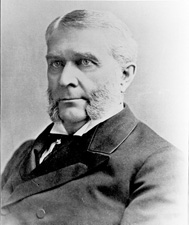William D. Washburn
William Drew Washburn | |
|---|---|
 | |
| United States Senator from Minnesota | |
| In office March 4, 1889 – March 3, 1895 | |
| Preceded by | Dwight M. Sabin |
| Succeeded by | Knute Nelson |
| Member of the U.S. House of Representatives from Minnesota's 4th district | |
| In office March 4, 1883 – March 3, 1885 | |
| Preceded by | District created |
| Succeeded by | John Gilfillan |
| Member of the U.S. House of Representatives from Minnesota's 3rd district | |
| In office March 4, 1879 – March 3, 1883 | |
| Preceded by | Jacob H. Stewart |
| Succeeded by | Horace B. Strait |
| Member of the Minnesota House of Representatives from the 5th district | |
| In office January 3, 1871 – January 1, 1872 | |
| Preceded by | Albert R. Hall |
| Succeeded by | E.D. Rogers |
| Personal details | |
| Born | January 14, 1831 Minneapolis, Minnesota |
| Political party | Republican |
| Spouse | Lizzie Muzzie Died May 1, 1916 |
| Alma mater | Bowdoin College |
| Signature | |
William Drew "W.D." Washburn, Sr. (January 14, 1831 – July 29, 1912) was an American
.Washburn was born in
Washburn built a mansion known as "Fair Oaks" in 1883. It was designed by E. Townsend Mix, who also designed Minneapolis's Metropolitan Building, and the outdoor landscape was laid out by Frederick Law Olmsted. The grounds included an artificial stream leading to a pond, a rustic footbridge, a greenhouse, and a carriage house. The home was demolished in 1924 to make way for a park, although the region is now part of the Washburn-Fair Oaks Mansion District, which was added to the National Register of Historic Places in 1977.
Washburn served in the Minnesota House of Representatives in 1871.[3] He was elected to the United States House of Representatives in 1878 and served from March 4, 1879, to March 3, 1885. He was elected to the Senate in 1888 and served from March 4, 1889, to March 3, 1895.
Washburn was a founder of the First Universalist Church of Minneapolis in 1859. A major benefactor, he served as a trustee and President for much of his remaining life. He died in Minneapolis in 1912. His grandson C. Langhorne Washburn was to be active in the Republican Party from the 1950s through the 1970s.
William Washburn's son,
References
- ^ Progressive Men of Minnesota (Minneapolis, 1897), p. 81
- ^ Gjevre, John A. (1990). Saga of the Soo, West from Shoreham (Second ed.). Moorhead, Minnesota: Gjevre Books.
- ^ Minnesota Legislators Past and Present-William Drew Washburn, Sr.
- ^ Gannon, Jack. 1981. Deaf Heritage–A Narrative History of Deaf America, Silver Spring, MD: National Association of the Deaf, pp. 147, 148, 149, 150
- ^ Minnesota Legislators Past and Present-William Drew Washburn, Jr.
External links
- United States Congress. "William D. Washburn (id: W000175)". Biographical Directory of the United States Congress.
 Media related to William D. Washburn at Wikimedia Commons
Media related to William D. Washburn at Wikimedia Commons
